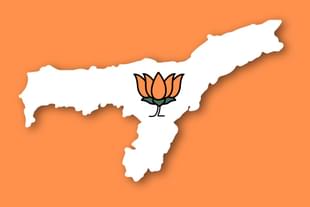Politics
Assam Panchayat Polls Dash Three Gogoi Alliance, Himanta Biswa Sarma Appears Set For 2026
Nabaarun Barooah
May 18, 2025, 09:40 AM | Updated 09:40 AM IST
Save & read from anywhere!
Bookmark stories for easy access on any device or the Swarajya app.


Jorhat was supposed to be the beginning of a comeback story. Congress's surprise victory in the Hindu-majority constituency during the 2024 Lok Sabha elections had opposition leaders speaking optimistically about cracking the BJP's dominance in rural Assam.
A year later, the Panchayat election results tell a starkly different tale—one where the Congress could manage just 3 anchalik seats in the very district that had given them hope, while the BJP swept 73. This comes as a sweeping statement of strength ahead of the crucial 2026 legislative assembly elections.
The Alliance That Wasn't
Emboldened by the Jorhat victory, three prominent leaders—Gaurav Gogoi (Congress), Akhil Gogoi (Raijor Dal), and Lurinjyoti Gogoi (Assam Jatiya Parishad)—had formed what observers termed the "Three Gogoi Alliance." The strategy seemed sound on paper: combine Gaurav's mainstream political appeal and lineage, Akhil's grassroots peasant movement credentials, and Lurinjyoti's Assamese and Ahom ethno-linguistic positioning to create a formidable anti-BJP front in Upper Assam.
The alliance aimed to capitalize on perceived dissatisfaction among Ahoms and educated Assamese Hindus—communities that had shown signs of drifting from the BJP in 2024. Their collective bet was that identity politics, combined with anti-incumbency sentiment, would dent the ruling party's rural dominance.
The 2025 Panchayat results reveal just how miscalculated this bet proved to be. Across rural Assam, the NDA's share of anchalik panchayat seats jumped from 55% in 2018 to 76% in 2025—capturing 1,436 out of 2,192 seats. Congress, meanwhile, saw its representation crash from 35% to just 18%.
The BJP alone secured 1,265 anchalik panchayat seats, while the Congress managed barely 401. The zila parishad results were equally emphatic: BJP took 272 of 397 seats, with the NDA total reaching 300. These numbers represent more than electoral gains—they signal a fundamental realignment in rural political loyalties.
The collapse of opposition hopes is most visible in the very areas where the Three Gogoi Alliance was supposed to be strongest. In Sibsagar, Akhil Gogoi's home district and a traditional center of Ahom identity politics, the BJP won 73 anchalik seats while Raijor Dal managed just 1. The NDA total reached 77, completely overwhelming the opposition.
Similarly, in other Upper Assam districts that the alliance expected to contest vigorously, the BJP maintained or expanded its dominance. The fragmentation of the Assamese and Ahom vote, rather than consolidating against the ruling party, appears to have either dispersed among multiple actors or shifted toward the BJP itself.
The alliance's failure wasn't just organizational—it revealed a fundamental misreading of rural sentiment that prioritized symbolic appeal over substantive grassroots work.
Beyond Upper Assam: A State-Wide Pattern
The BJP's success wasn't confined to Upper Assam. Across most of Assam's districts, the party emerged victorious in direct contests with Congress. The exceptions—Barpeta, Darang, Dhubri, and Hojai—are minority-dominated areas where religious identity politics traditionally play a larger role.
Even here, the ruling alliance demonstrated strategic sophistication. In Barpeta and Darang, the combined NDA tally exceeded Congress numbers, largely due to the Asom Gana Parishad's regional strength and its effective role within the ruling coalition. This pattern suggests the BJP has moved beyond its initial base to build a more diverse rural coalition that spans communities and regions.
Several administrative initiatives appear to have influenced these results. The Orunodoi cash transfer scheme has emerged as a significant factor across demographic groups, providing direct financial assistance to families. The government's job creation drive—reportedly over 1 lakh government positions filled—resonates strongly in a state where employment remains a critical concern.
Cultural initiatives have played an equally important role. Events like the Jhumoir Binondini festival demonstrated government engagement with indigenous traditions, particularly appealing to tea garden communities who have historically felt marginalized. This approach of embracing regional identity while maintaining broader ideological coherence appears to have neutralized much of the ethno-nationalist opposition.
Chief Minister Himanta Biswa Sarma's emphasis on infrastructure development, anti-corruption drives, and improvements in healthcare and education has created a perception of decisive governance that translates effectively at the grassroots level.
2026 and the Road to Dispur
These results significantly alter calculations for the 2026 assembly elections. The BJP's stated goal of winning 104 assembly seats—which would secure a third consecutive term with an enhanced majority—appears far more achievable given this rural mandate.
The party now commands an extensive network of elected Panchayat representatives who can serve as mobilizers and influencers in their localities. This organizational advantage extends well beyond vote counts, providing crucial infrastructure for the larger electoral battle ahead.
For the opposition, the results pose existential questions. Congress faces a deepening organizational crisis, having lost significant ground in its traditional rural base. The failure of the Three Gogoi alliance suggests that symbolic coalitions require substantial organizational groundwork to succeed—something the opposition clearly lacked.
Raijor Dal and AJP, despite their spirited rhetoric, must now confront the gap between political messaging and electoral machinery. Both parties need fundamental reassessment of their approach to coalition building and grassroots organization.
The 2025 Assam Panchayat elections mark a decisive moment in the state's political evolution. They demonstrate that the 2024 Jorhat result, rather than signaling a broader trend, represented an isolated victory that the ruling party has effectively neutralized through sustained rural outreach and administrative performance.
Rural Assam has delivered a clear verdict that reshapes the political landscape ahead of what promises to be a defining assembly election. The traditional competitive patterns that once characterized Assam politics have shifted substantially, creating new realities that all political actors must now navigate.
Whether the BJP can convert this rural momentum into a historic third term, or whether the opposition can mount a credible comeback, will define not just the 2026 elections but the trajectory of Assam politics for years to come.





